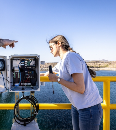New probes gather real-time algae information in CAP canals
Published on by Water Network Research, Official research team of The Water Network in Case Studies
Immediate information valuable for agricultural farmers
Taylor Weiss lowers the probe into the bottom of the canal and waits for the conversation to begin.
“Hey, how are you feeling today?” the probe says to the algae. “Are you happy? Or are you not?”
The answer to those questions enables Weiss and his team at the Arizona Center for Algae Technology and Innovation, or AzCATI, to detect algae blooms in real time in the canal system, information that is critical to homeowners and agricultural farmers throughout Arizona.
“The whole part of our sensor system is you can see the problems as they’re coming,” said Weiss, a senior global futures scientist at Arizona State University’s Julie Ann Wrigley Global Futures Laboratory and assistant professor in the Polytechnic School, part of the Ira A. Fulton Schools of Engineering. “It’s like a weather forecast. Just by letting people know when an event is going to hit, they can adjust.”
Through a partnership with Burge Environmental, which developed the new technology, AzCATI has a half-dozen probes testing the water in the 336 miles of the Central Arizona Project canal system, as well as Lake Pleasant.
The probes, powered by solar energy and connected to a computer terminal that sends out data like a cell phone, are essential because drought conditions brought on by climate change — “everything that could make the situation worse is now happening,” Weiss said — can create “extremely problematic” algae changes, and previously there was no way to gather immediate information.
“There was no practical way without having an army of people grabbing samples physically across 300 miles of canal,” Weiss said, adding that it’s impossible to keep algae from blooming in the CAP canals. “Not just monthly, not even weekly, but daily, to even establish a pattern. And then what tests are you going to run? Now we have a real-time potential measure of biological activity in the environment.
“Fundamentally, what we can now say with much greater confidence — is the algae growing slow? That’s because it was cold yesterday. So, it’s a cloudy day, they’re growing slow and that’s fine. Or, if they’re growing slow and we think they should be growing faster, we need to find the reason because that’s an opportunity for improvement.”
Biological design doctoral students Duane Barbano (left) and Dorsa Daeizadeh attach a telecommunications unit and battery to a tower railing at Lake Pleasant. The crew, led by Assistant Professor Taylor Weiss, installed both a floating and a fixed probe network to measure the biochemical activity of the environment.
 Photo by Charlie Leight/ASU News
Photo by Charlie Leight/ASU News
The continuous, real-time testing of the algae bloom is vital for several reasons. First, if the algae Cymbella – often called “rock snot” for its sticky, yellow, clumpy form – grows too quickly, it can reduce the efficiency of water flow. While a sticky canal may not seem like a big deal, that energy loss could instead be powering thousands of homes each year, Weiss said.
“The state of Arizona spends 4% of its annual energy on this canal,” Weiss said. “So, you start doing the math and very quickly it’s a gross inefficiency.”
It’s also important to know what type of algae is growing in the canal system. Some algae create “odor and taste issues that people drinking water don’t enjoy.”
The real-time information is also helpful to agricultural farmers, who depend on a consistent water supply from the canals.
“If they know a problem is coming, like the intakes being clogged, a problem at 9 a.m. on Monday is an easy problem to solve, while a problem at 2 a.m. on Sunday is difficult,” Weiss said. “Because we don’t have the manpower in place across a very large area, you’re ill-prepared, which means the system will be running inefficiently and it’s going to disrupt users.
“So knowing the problem and understanding how to predict it, this is algae forecasting. The hard part of our job now is we’re in the stages of taking relatively simple data and trying to break it down to something as simple as a weather forecast. Like a map where you have sensor platforms, we’ll have a number from one to five saying how bad the algae is in this region based on water flows. And if we know they’re breaking loose in one place, we can say, ‘Hey guys, in 48 hours this problem could be at your doorstep.’”
Weiss hopes the new sensor system can be used beyond the CAP canals. He said he recently met with the Mesa city council; Mesa gets approximately one-third of its water from CAP, one-third of its water from Salt River Project and one-third of its water from groundwater sources.
Taxonomy
- Algae
- Cell and Molecular biology, Plant biology, Algal biology